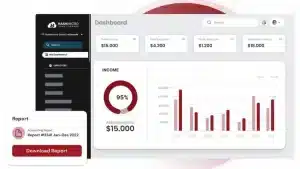Managing financial reporting can be challenging for many managers, especially when accuracy and compliance are crucial for assessing business performance. Financial reporting is a company’s main source of insight into its financial health, which is why manual financial management has largely been replaced by advanced accounting software.
Financial reporting software offers an ideal solution that efficiently handles each component of financial statements and minimizes the risk of errors. This technology allows managers to focus on interpreting data rather than dealing with time-consuming manual calculations and adjustments, which are critical for making strategic decisions.
With the help of integrated accounting software, reporting software can provide real-time updates, helping to document each component of financial statements—assets, liabilities, and equity—accurately and consistently. This streamlined approach aids in tracking growth, meeting regulatory standards, and building stakeholder confidence.
Curious to learn more? Read on to discover the 5 component of financial statements that every business should understand. These basic components of financial statements play a key role in strengthening a company’s financial health and guiding future growth.
Table of Contents

Key Takeaways
|
What are Financial Statements?
Financial statements are essential documents that clearly show a company’s financial health. They’re structured to give stakeholders insights into revenues, expenses, assets, and liabilities, making them invaluable for decision-making.
Typically, component of financial statements come in four primary forms: the income statement, balance sheet, cash flow statement, and statement of changes in equity. Each serves a specific purpose and contributes unique details about the company’s performance and overall financial position.
Furthermore, these documents help identify trends and assess a business’s stability over time. By reviewing these statements regularly, companies can make more informed choices, adapt to market changes, and foster long-term growth.
How Financial Statements Work

Financial statements are a critical tool for evaluating a company’s financial health, guiding both management and investors in decision-making. By presenting detailed financial performance records, they help ensure transparency and accountability within the organization.
In addition to their importance, year-end accounting plays a crucial role in ensuring that all financial transactions for the year are accurately recorded and properly reported. By completing year-end accounting, businesses can prepare for tax filings, comply with financial regulations, and ensure that financial statements accurately reflect the company’s performance for stakeholders.
In the Philippines, companies must comply with Philippine Financial Reporting Standards (PFRS), which align closely with International Financial Reporting Standards (IFRS). This regulation helps Filipino businesses present a clear, standardized picture of their finances, building trust among investors and regulatory bodies.
Additionally, component of financial statements in the Philippines are regularly audited to ensure they reflect a true and fair view of the company’s financial standing. This approach further supports accuracy and reinforces the importance of trustworthy financial reporting software for the benefit of all stakeholders.
Also read: Understanding Manufacturing Financial Statements’ Importance
5 Components of Financial Statements

Before exploring the five components of financial statements, it’s helpful to understand their role in conveying a company’s financial health. Each component offers unique insights, forming a complete picture for stakeholders and investors.
Tingnan natin kung paano nagtutulungan ang mga bahaging ito upang masiguro ang malinaw at tumpak na pag-uulat ng pananalapi:
1. Income statement
The income statement is one of the most essential parts of financial report. It offers an overview of profits or losses within a given period and is divided into two main sections to provide a clear financial picture.
The first section reveals the gross profit or loss, calculated by subtracting the cost of goods sold from total income. To obtain this, combine the opening stock with net purchases, then subtract the closing stock for an accurate view of initial earnings.
The second section shows net profit or loss derived from gross profit by deducting operational expenses—like salaries, taxes, and rent. Integrating a purchasing system can enhance cost-efficiency and make procurement costs easier to manage.
2. Balance sheet
The balance sheet highlights a company’s ability to fulfill its obligations by comparing assets against liabilities. This component provides a snapshot of the company’s financial health at any given time.
Start by recording non-current assets, such as machinery, computers, and office furniture, which have long-term value. Next, add current assets, including cash, accounts receivable, and inventory, which are expected to turn into cash within a year.
Liabilities include non-current and long-term debt, as well as current, like trade payables and bank overdrafts. Overall, the balance sheet template captures your company’s equity, offering stakeholders a valuable view of financial stability.
3. Cash flows
The cash flow statement provides a summary of cash inflows and outflows, covering operational, investment, and financing activities. It tracks all cash transactions, offering insights into liquidity and cash management.
Cash flows from operations reflect daily activities such as sales and purchasing inventory. Investment cash flows include earnings or expenses from long-term projects, while financing covers share sales and dividend distributions.
Integrating with a CRM-Sales System can streamline the tracking of outstanding payments from customers, which ensures a smooth cash flow. Proper cash flow management helps businesses meet immediate financial obligations and plan for growth.
4. Changes in equity
The statement of changes in equity reflects the evolution of a company’s equity over a specific period. This component captures the beginning and ending equity balances, including any changes in value.
This statement provides details on the sources and uses of equity funds, helping managers and investors understand variations in ownership value. Regularly reviewing changes in equity gives insight into retained earnings, owner contributions, and dividend payments.
Tracking these changes is essential for assessing business growth and shareholder value over time, offering a transparent view of equity fluctuations.
5. Note to financial statements
Financial statements consist of essential components that together paint a full picture of a company’s financial position. Each component of the financial statement, such as the income statement, balance sheet, and cash flow statement, serves a unique purpose in providing insights into financial health.
These component of financial statements reveal assets, liabilities, and profitability, ultimately aiding in strategic planning while ensuring compliance with BIR’s CAS requirements in the Philippines. Moreover, HashMicro’s BIR-accredited, CAS-ready software streamlines financial processes, helping businesses maintain accurate records and effortlessly meet CAS policies.
Also read: A Guide to Electronic Invoice System BIR Philippines in 2024
Streamline your Financial Reporting with HashMicro Accounting Software

HashMicro’s accounting software is a BIR-accredited, CAS-ready solution designed to help businesses in the Philippines meet BIR standards effortlessly. By automating financial processes, companies can ensure accurate records and streamline compliance with CAS requirements, making financial reporting smoother and more reliable.
To give potential clients a firsthand experience of its capabilities, HashMicro provides free demo access to its accounting software. This demo allows businesses to explore the software’s functions and features with no initial commitment, helping them make a well-informed decision.
The following are some of the features provided by HashMicro’s financial management software that will help companies with financial reporting:
- Accounting and Financial Statements: HashMicro provides complete financial statements tailored to meet reporting needs, with flexible period comparisons for accurate tracking over time. This feature enhances clarity in financial reports, supporting well-informed decisions based on comprehensive data.
- Bank Integrations – Auto Reconciliation: With automated bank reconciliation, HashMicro syncs bank transactions directly, ensuring accuracy and reducing manual effort. This seamless integration saves time and minimizes errors, providing confidence in financial data.
- Multi-Level Analytical Reporting: Analyze financial performance by project, branch, or any business unit with ease, offering detailed comparisons across segments. This multi-level analysis enables targeted insights, helping you understand and optimize each area’s financial impact.
- Profit & Loss vs Budget & Forecast: HashMicro’s software compares actual profit and loss with budgeted and forecasted figures, enabling real-time performance evaluation. This feature supports proactive adjustments, ensuring businesses stay on track with financial goals.
- Cash Flow & Forecast Management: Cash flow reports and budget forecasts provide a clear view of incoming and outgoing funds, facilitating better financial planning. The S-curve visualization makes budget tracking more intuitive, aiding in resource allocation and cash management.
- Financial Ratios & Equity Movement Report: Financial ratios offer an in-depth look into profitability, liquidity, and financial health, while equity movement reports track ownership changes. These insights allow businesses to assess performance and make sound strategic decisions.
- Automated Currency Updates & Intercompany Consolidation: Real-time currency updates simplify international transactions, and intercompany consolidation streamlines reporting for multi-entity businesses. These features ensure accurate consolidated financial statement reporting across companies, enhancing transparency in global operations.
- 3-Way Matching & Custom Invoicing: Streamline procurement with three-way matching, automatically aligning invoices, delivery orders, and sales orders. Customizable invoice printouts cater to different transaction types, enhancing flexibility in documentation.
In addition to these features, this software also supports unlimited users, has flexible customisation options, and seamlessly integrates with other modules or third-party applications, making it an adaptable and comprehensive solution for any company.
Conclusion
Understanding the core components of financial reporting is crucial for any business, as it provides a clear view of financial health. Accurate reports foster trust and enable better decision-making among stakeholders.
For businesses in the Philippines, HashMicro’s Accounting Software is an excellent choice, as it aligns with the BIR’s Computerized Accounting System (CAS) requirements. With automated processes, it ensures compliance, accuracy, and real-time tracking tailored to local regulations.
Streamline your financial reporting process with HashMicro’s Accounting Software—try a free demo and consultation with our expert team to see how it fits your business needs.





































